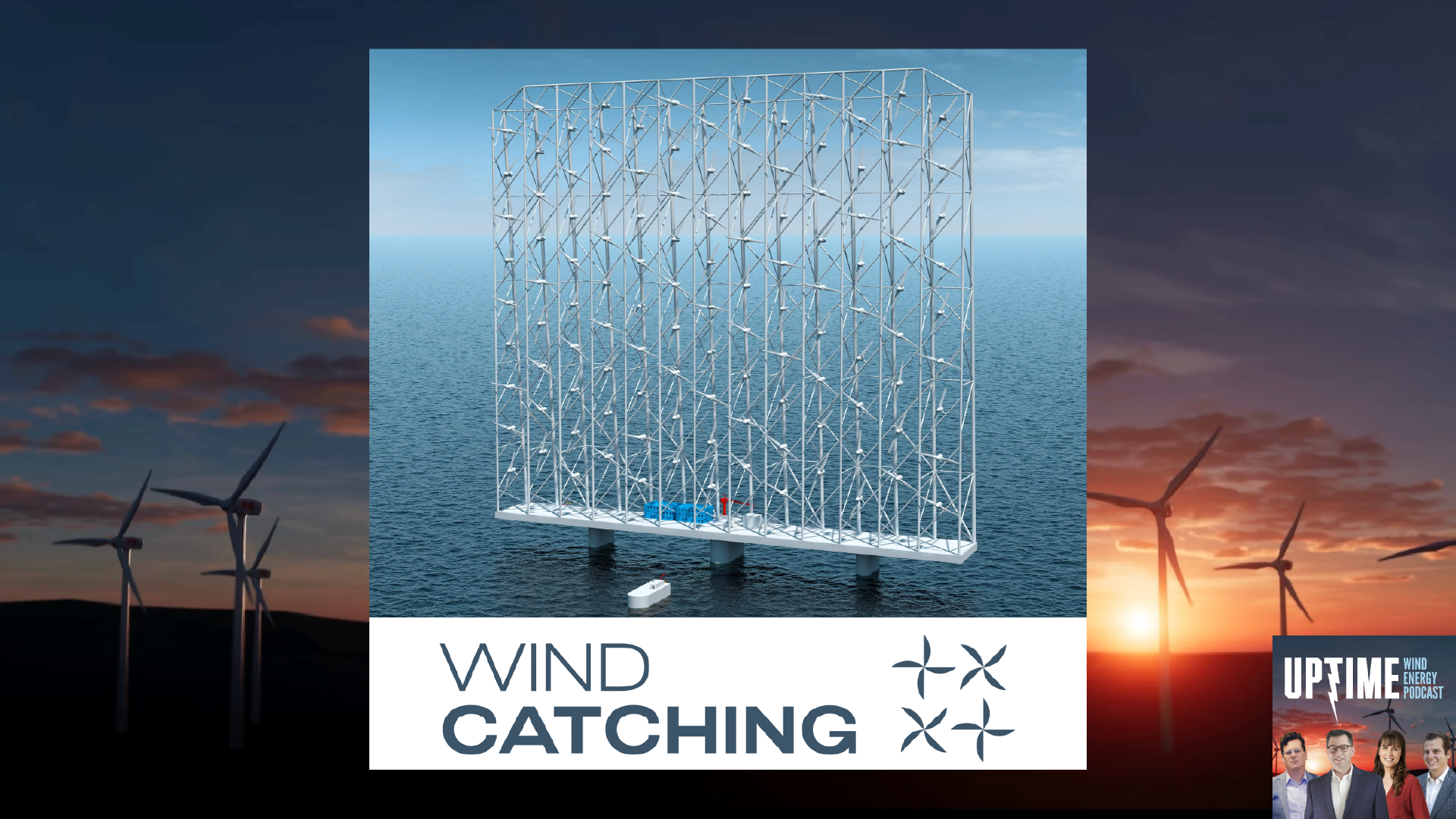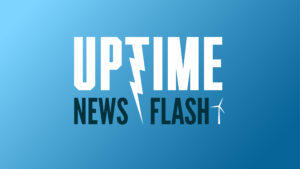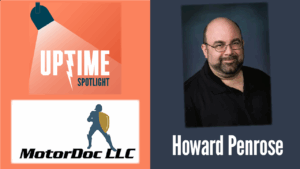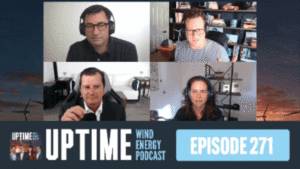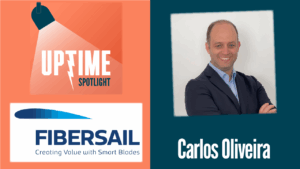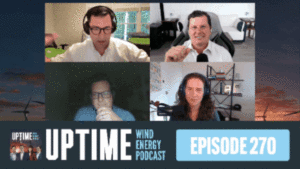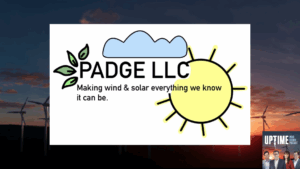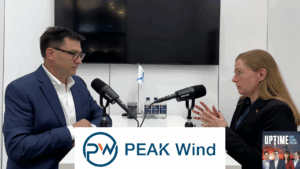Podcast: Play in new window | Download
Rosemary interviews Ivar Knutsen, Senior VP of Technical and Supply Chain at Wind Catching Systems, to discuss their innovative floating offshore wind concept. Wind Catching’s design features a grid of small wind turbines that benefit from the multirotor effect and enable easier installation and maintenance compared to traditional large offshore turbines. Wind Catching will also present at the Multi Rotor 2024 seminar June 12-13. You can find more information here: https://multirotor24.zohobackstage.eu/MR24.
Sign up now for Uptime Tech News, our weekly email update on all things wind technology. This episode is sponsored by Weather Guard Lightning Tech. Learn more about Weather Guard’s StrikeTape Wind Turbine LPS retrofit. Follow the show on Facebook, YouTube, Twitter, Linkedin and visit Weather Guard on the web. And subscribe to Rosemary Barnes’ YouTube channel here. Have a question we can answer on the show? Email us!
Pardalote Consulting – https://www.pardaloteconsulting.com
Weather Guard Lightning Tech – www.weatherguardwind.com
Intelstor – https://www.intelstor.com
Rosemary Barnes: Welcome to a special episode of the Uptime Wind Energy Podcast. I’m your host, Rosie Barnes, and I have today with me Ivar Knutsen who is the Senior Vice President for Technical and Supply Chain at Wind Catching. Thanks for joining us, Ivar.
Ivar Knutsen: Thank you for inviting us, Rosie.
Rosemary Barnes: Okay, so for those who don’t know, I’m just gonna quickly start by summarizing what the concept of Wind Catching is.
So basically it’s a grid of wind turbines that is floating offshore. So you’ve got a whole lot of small wind turbine turbines arranged in the grid, and they’re benefiting from being close to together with the multirotor effect, which we’ll get into later. And obviously there’s also, more modularity all the.
Turbines are arranged in this grid so that they can all yaw at the same time to face a differing wind direction. And yeah I’ll hand it over to you Eva to explain more about what the concept is and yeah, why you decided that this was a, an interesting company to get involved with.
Ivar Knutsen: It has become apparent to us that there are fundamental differences Between a bottom fixed and a floating wind turbine and they those differences are so big that you might need to Take a second look at that, you need to maybe consider a completely new approach to the design, but also to the operation.
So we find that multi rotors have three or four key benefits. One is that you’re actually able to avoid. The infamous tow to port. If the turbines are sufficiently small, you can handle them offshore and perform a turbine replacement offshore without using a crane vessel. You just need to bring people aboard a unit as long as you have the right technology to, to do that.
And as, as we see it, there are no options for. Return to port for big single rotor floaters today, there are many concepts out there, but we don’t see any of them as being tackling the real problems is that it’s going on in an offshore environment with a lot of motions. The other thing we also find very interesting about multirotors is that you decouple the turbine development from the sort of the development, both on the supply chain, but also on capacity.
So if you can go from 20 to 30 to 40 megawatts without developing new turbines for every single step, that’s interesting. If you can use the same turbine, But you can change your installed capacity by building on your support structure. That is a very interesting part of the multirotor concept.
And the other thing is that with a standardized turbine, you can actually enable a much broader supply chain. You can enable local content in each country because the sophistication required to turbine is much lower. And the reason for that, this is that if you now look at the biggest turbines and the turbines expected to come later.
With blade lengths of 120, 130 meters to overcome the scaling effect where the weight of those blades should scale cubically with the length. They actually scale by the square and that is done by introducing more and more sophisticated technology in the blade design and manufacturing, which is really important.
Prohibitive to local content. You can’t build those plates just anywhere.
Rosemary Barnes: Let’s cover though what you said about the modularity and the supply chain. So I think that’s really interesting. I think that’s something that most people are aware of that, modular technologies tend to reduce their cost faster.
If you look at the difference between solar panels and wind turbines, that’s a big difference is that the solar panels are a lot more modular and they’re yeah, can make the exact same thing many more times, which tends to lead to, yeah, getting better at manufacturing that thing and, making it cheaper.
Then there’s other physical thing that you mentioned about how the structural scaling laws, the amount of wind that you capture it scales with the square of the length of the blade, but the volume scales with the cube. So you actually. Don’t get a better structural outcome from having a big, one big rotor.
You have a better structural outcome, like a, less material should be able to be used if you have a lot of small rotors than one equivalent large one. Yeah, so maybe you can talk a little bit more about that benefit that you expect to get from the modularity and the supply chain.
Ivar Knutsen: What we’re working on now is a 40 rotor unit. So a 40 rotor floater which we see as perhaps the lower scale or at least the lower region of what we see as a fully commercial, not the pilot size, but they fully commercial size. And I say for three rotors and the turbine we are designing is a one megawatt, 30 meter diameter turbine.
So 40 rotors is 40 turbines 40 megawatt. Having said that we have. That kind of scalability on the turbine rating, we wouldn’t probably wouldn’t differ in turbine diameter in rotor diameter, because that has implications on the, how the design of the structure, not only the, how you scale the structure, but the whole sort of arrangement of the structure.
But of course, turbine rating is something you can play with on project specific basis, because we do see project. Different types of projects, different types of markets. Even if you start looking at electrification projects, where what we see, interestingly, when I say electrification electrification of oil and gas platforms, which is, has been done in Norway for some time, and it’s probably coming to Scotland as well.
They are often very clear and they have a clear cap on what they can receive of power because their facilities can’t receive any above, any sort of access power can’t be Received or utilized.
Rosemary Barnes: So yeah, you mentioned a couple of terms there that not everyone might be familiar with. So you mentioned that there the rating is higher.
Ivar Knutsen: So meaning basically we have a higher rated wind speed and a bigger generator relative to the rotor size.
Rosemary Barnes: Yeah. And it’s usually an economic optimization to figure out what that size should be. And you’ve come up with a different answer than. Than others. Is that what you’re saying?
Ivar Knutsen: Absolutely. And and it’s an interesting question because you’re coming back to why our turbines like they are today. And that’s not a straightforward question to answer, because there’s so many, there’s an evolutionary history that has led them in a certain direction. But if you consider very large offshore turbines today, we see that the rated wind speed has gone down.
typically gone down to now. If you see turbines 10 years ago, they were maybe had ratings of 12 meters per second. And now we’re see down to 10. 5. You could get immense capacity factors by just reducing it down to say rating at a five meter per second. And you would get like a very good capacity factor, but it doesn’t make sense.
Rosemary Barnes: You wouldn’t get a lot of annual energy production though.
Ivar Knutsen: Yeah. So what I would say is that for very large rotors what I believe is that the cost of generator size, so increasing a generator size by 5 percent for a 15 megawatt turbine is, has immense consequences. First off, you actually have to build this, but you have to install it and you have to transmit the rotor loads through this.
And this comes from the same kind of scaling law, but that applies to us as well. It just applies in the other direction. So we have a very, a much, much lower impact on that. So we could increase our generator size or decrease our generator size by 20%. And it wouldn’t really matter too much.
Rosemary Barnes: Because it’s still a very small generator compared to what we’re used to handling.
Ivar Knutsen: Yeah. So you’re saving three tons of generator weight per turbine, maybe if you make a substantial change. And as long as you can handle the turbine well. Why not just make a big generator? And that’s what we’re doing.
Rosemary Barnes: Yeah. Okay. That’s really interesting. And I’m sure that there are, a thousand different little tiny things like that, that are different for your design than a regular configuration. But I just want to go back to one other technical point that you mentioned that people might not be familiar with.
You said one P and three P that’s a tower passing frequency, right? Which I guess when you’ve got a single. tower with a, a three bladed rotor on it, then that’s obvious what that means every time that the yeah, there’s a certain frequency of when the blades are passing the tower. Your design has this big grid latticework there’s not just one tower and three blades anymore, there’s What have you got, 120 blades if you’ve got three blades per rotor and all sorts of components of a tower latticework.
That’s opening a huge can of worms structurally, right? Because I know that, resonant frequencies and all those sorts of things and dynamic loading yeah, all these aerodynamics interferences. Have all been things that the history of wind energy is, littered with people that were surprised by these effects, and had, sensible looking designs that just, shook themselves apart.
So what have you, I’m assuming that a lot of the development that you’ve been done has been on under understanding how these are gonna work for your unique design. Can you tell me a bit about what you have done there?
Ivar Knutsen: Yeah. It’s absolutely right. Because we see that. Because when you design the traditional turbine, you want to tune your tower to have a certain natural period or a certain set of natural periods.
And if you have a lattice work, you basically have thousands, if not hundreds of thousands of structural modes that where one turbine could by chance trigger a vibration far away at the other side of the lattice, just by, because there’s this you happen to trigger some, it’s like an interior of a car.
There’s always something rattling and it’s almost impossible to design your way around that kind of rattling because you’re exposed to so many different frequencies, different motor RPMs. Basically we’ve said that there’s no way to try to design your way around that you need to embrace it and accept it.
So what we’ve done, two things we’ve done we have a fairly big distance between the blade and the tower. So we have about five meters, which for such a small rotor is actually quite a long distance. So, and we’ve done some work on seeing how big that distance should be before the kind of the aerodynamic pulse cost.
On the on the rotor, but also on the structure is lessened. And the other thing we’re doing, and that’s we’ve done a few structural simulations where we applied vibrations to all the turbine locations and starting extracting the responses in all these members. And what we’re looking for is we’re not looking for these single extremes.
We’re looking for what is the average fatigue damage that this. Applies to the structure so that you can add it to your fatigue budget when you’re doing a fatigue design of the structure and by that you can obtain stress amplitudes. And you can see the stress amplitudes caused by this and try to say, okay, there’s this fussy picture that we don’t know exactly what’s happening inside this fussy picture, but we know that the envelope of it.
So we will design our way. around this kind of, we have a top and bottom and say, okay, we will accept what’s going on in there. And that’s the approach.
Rosemary Barnes: When you say you’ve done tests, are you talking computer simulations? Are you talking small scale models in wind tunnels?
Ivar Knutsen: Computer simulation. So we’ve done a, in a time domain software.
Rosemary Barnes: Early on you mentioned about maintenance strategy. I think that’s something else that’s quite interesting with this multi rotor design. So yeah, if you’ve got 40 wind turbines and one of them gets knocked out, what’s that two and a half percent power reduction. I’m assuming it’ll also cause some, funny structural things, but you’ve already mentioned that your design, your plan is to not have yeah, you’re not designed so that the frequencies matter that much that would affect it, I’m assuming.
Guess you’ll know for sure when you’ve built one, but how would it work? One rotors out, so you send out a repair crew or you wait for two, three, four, like at what point, and do you have to stop the whole 40 to go work on one? Cause I’ve, I climbed wind turbines for my work and you, you definitely, you don’t want to be up there while it’s cranking.
Yeah, what’s the strategy?
Ivar Knutsen: So imagine the event you have 40 turbines. If you look at failure rates on a number of failures per turbine we account for turbines stopping or. That we choose to stop them because we have some alarm on some sensor that not sure what’s going on there, but let’s stop the turbine.
And then we say, okay, let’s, this is happening now in December, a very difficult time in Europe for doing anything offshore. But as you say, it’s a very small percentage of the total production, so we can just leave that for now. And then we see that, okay. We have, we are planning with regular intervention campaigns.
So once the two rotors have stopped or maybe three rotors have stopped, okay. We decide to do an intervention campaign and and maybe basically that is limited by the ability to put people on board a unit. So which are the same limits as any kind of both floating and bottom fixed have today that you have a.
wave height limitation of around two and a half meters and a wind speed limitation of 15 to 20 meters per second, actually quite high for these walk to work systems. So you send out this your service ship with your crew, your small team. And They use this elevator they shift the elevator to right position.
They try they move to the right turbine. They do an inspection. And either they decide that, okay this, that was a faulty sensor. There was nothing wrong. And or there was something significantly wrong. And you either restart the turbine or you do something or you plan for a longer, a more substantial replacement.
And yes. Would you stop all the rotors at that time? So what I’m understanding is that some developers or operators of wind farms, they are happy to have people on the TP when the rotor is going. And it’s a sort of a risk Management thing, I would say that you wouldn’t have any kind of rotors moving in vicinity of this elevator because when that’s moving, regardless of if there’s people on it or not, because you’re doing stuff very close to moving rotors.
So you don’t want to lose a spanner and then it falls onto a rotor, which is already spinning or something. That’s so it is a risk management thing that you do. It’s not technically impossible to do it. So, Basically, the system we have allows you to have a working, a safe working platform at your turbine, just next to your turbine, allowing you to do an inspection, but also allowing you to do a blade replacement or a complete miscellaneous replacement.
So for the blade replacement are what we’re working on is basically to have a rack of blades that you prepare the rack of three blades on shore in your warehouse and the blade stays in those in that rack until on the elevator and until the You’re up next to the turbine. So you have your blade rack right next to your turbine, allowing you to do a complete rotor replacement.
And our target is that we should be able to do that during one shift. And if we were to do a turbine replacement, we would have to take the blades off, bring them down to deck, and then do the turbine separately, at least in the first round, but we can do it but. The idea is that we don’t do repairs up there.
If they’re running in the, the difficulty of doing a turbine replacement should be sufficiently low that you don’t bother with it, just swap it. So idea is that you have a pool of turbines and blades on shore. And you can rotate. So if you have one turbine with some slight issue, okay, we’ll swap it out and we’ll figure out on shore what’s going on with that turbine if we want to do something which means that the criticality of having a turbine failure.
It comes lower, so you don’t need to design it so that you absolutely sure that it never fails.
Rosemary Barnes: Yeah. It’s a really dramatically different approach and it does seem like you’ve covered a lot of a bit of a best of both worlds because, there’s a reason why people have gone bigger and bigger for offshore turbines and, a lot of it’s to do with the number of connections, electrical connections that you need.
It’s just simply expensive to have Yeah. Underwater cables and connection points and everything, but you would still have fewer of those, but you also get rid of yeah, a lot of the downsides of the really big turbines that you’ve already mentioned.
Ivar Knutsen: So with turbines becoming very big, it has like a commercial momentum.
That means that yes, you can do innovation, but. The costs of doing something significantly different become prohibitive to doing it because yeah, there there’s so much invested now in the current direction, the factories, the designs that it’s becoming more difficult to disrupt.
And what we find very interesting is that there’s a whole range of onshore OEMs that are not in offshore wind today. And basically for them to enter offshore wind is an enormous technical lift and commercial lift. So they, let’s say a onshore OEM who wanted to enter offshore wind today, what would they need to do?
Probably they would need to launch a 16, 17 megawatt offshore turbine. And that’s that just the cost of developing something like that is enormous. So it is prohibiting them from it’s certainly Makes it very difficult for them to enter the market, meaning that new OEMs are not likely to come in soon.
What we think we can offer with a multi rotor approach is that we can actually introduce these new OEMs to the offshore wind market. Because a one megawatt turbine, there’s a significant higher number of companies that can do that. Also on the component side. That’s where you can use more local suppliers.
We see that in Norway we see it in Scotland to produce a generator or produce a fairly straightforward 15 meter epoxy blade. There’s a lot more companies that can do that. And that I think is good that you can broaden your supply chain. Because I think the supply chain is perhaps one of the biggest constraints we have in offshore wind today.
Rosemary Barnes: So you mentioned so far you haven’t built any prototypes for testing, but I assume that would be the next step would be to it will be a step to build a unit and get it out in the water. How far along the path to that are you? When do you think we’ll see that?
Ivar Knutsen: So what we’re doing is that we have our turbine development program.
We have a license to test a prototype in Norway. So from the regulator We actually did a a model test two weeks ago in a tank in Norway. So we did a hydrodynamic model test of quite a, it’s quite a big model hub. We’ll share some pictures soon. Then we’re working towards this this 40 megawatt unit.
And. Saying, okay, what are the big validation needs? What are the big sort of uncertainties? And we’re tackling those and then seeing, okay, how can we pilot this specific problem in order to understand it as well as possible? So say blade passing effects, two blades passing at high speed. How do you understand that mechanism and that the physics best?
CFD, maybe not, wind tunnel, yes, maybe, or maybe all of that. So that’s how we’re thinking at the moment. Can I actually, in the last minute, promote that the University of Strathclyde and University of Hamburg are hosting a multirotor seminar in June? We had one in Hamburg last year, which was very good, very interesting.
It is a seminar for those infected by the multirotor virus. And I invite people to look it up on LinkedIn.
Rosemary Barnes: Thank you so much for talking to us about Wind Catching. I’m definitely going to be following your progress closely. I hope you’ll keep us up to date and I really wish you the best of luck.
Ivar Knutsen: Thank you very much.



